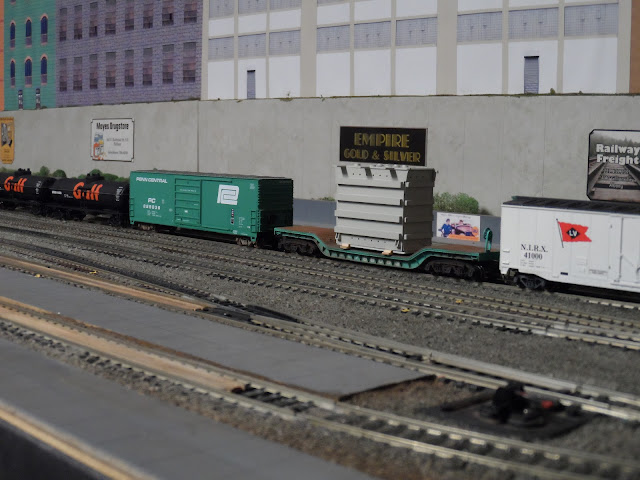Greetings All,
In our recent virtual model railroad operations known as the Penn Central Car Movements the placement of a pair of tank cars loaded with diesel fuel and some other cars with dangerous loads within their trains just did not look right.
The issue was very noticeable in PCCM 87 with this LIRR diesel coupling up to two tanks cars of diesel fuel that are coupled to a pair of gondolas loaded with poles which are above the gondola sides. The last gondola will be coupled up to the LIRR caboose for their trip. I believe we can do better than this.
PC Ralph agreed and sent me this book for Christmas to read up on the Penn Central Hazardous Material Regulations. General Notice 225-F was effective May 15, 1969 and revised on January 1, 1974. The book details Hazardous Materials Regulations applying to rail freight service.

A two car buffer between locomotive and crew is in compliance with the regulations which call for a minimum of two cars and a preferred six car buffer where possible.

(j) Separating loaded tank cars placarded "Dangerous" from other cars in trains. In a freight train or mixed train either standing or during transportation thereof, a placarded loaded tank car must not be handled next to:
(1) Occupied passenger car, other than cars occupied by gas handlers and authorized personnel accompanying shipment.
(2) Occupied combination car, other than cars occupied by gas handlers and authorized personnel accompanying shipment.
(3) Any car placarded "Explosives"
(4) Engine or occupied caboose (except when train consists only of placarded loaded tank cars).
(6) Wooden underframe car (except on narrow gauge railroads).
(7) Loaded flatcar, other than specially equipped cars in trailer on flat car service or flat cars loaded with automobiles, trucks, or trailer bodies that are secured by means means of a device or devices designed and permanently installed on the flatcar for that purpose and of a type generally accepted for handling in interchange between railroads.
(Note: Flatcars equipped with permanently attached ends of rigid construction shall be considered as open top cars as in sub paragraph (8) of this paragraph).
(8) Open top car when any of the lading protrudes beyond the car ends or when any of the lading extending above the car ends is liable to shift so as to protrude beyond the car ends.
New York Central RR New York District, Grand Central Terminal Division and Hudson Division Timetable No.22 dated October 29, 1967 page 278 states that "Pulpwood loaded in open top equipment is not to be handled in Symbol Freight Trains. Trains containing such cars must not exceed 25 mph on tangent track and 15 mph on curves.
(9) Car, trailers or truck bodies on flat cars with automatic refrigeration or heating apparatus in operation, car, trailers or truck bodies on flatcar with open-flame apparatus in service or with internal combustion engines in operation.

Going forward with the virtual operations and my own car card and waybill operations placement of placarded tank cars and dangerous loads will be monitored more closely and the use of buffer cars will be implemented as needed to protect crews, loads and the public.
Trains leaving Terminal Yard will meet the two car buffer requirement at minimum and the six car requirement whenever possible.













Your reading of the HAZMAT regs book and examples of our 1/87th scale violations has motivated me to make sure the crew at West Mill goes through re-training! :) Buffer cars and appropriate placement of hazardous loads will be implemented in future PCCMs to approximate more realistic ops! Nicely done!
ReplyDeleteThe book has provided great information that should work well in the PCCMs!!!
DeleteWow! Some detailed regulations to follow moving hazardous and flammable materials. I think it’s going to add some interesting challenges to the PCCM. I might be a way to fit in some old and neglected rolling stock as buffer cars. I see rusted and old covered hoppers used on the current prototype as buffer cars. Some beat up heritage road cars nearing their 50 year anniversary might do the job 👍 Really great information 😊🚂
ReplyDeleteThanks ATJOE!! As you saw we felt the need to improve our car handling and the tankers with their flammable liquids definitely needed our attention.
Delete